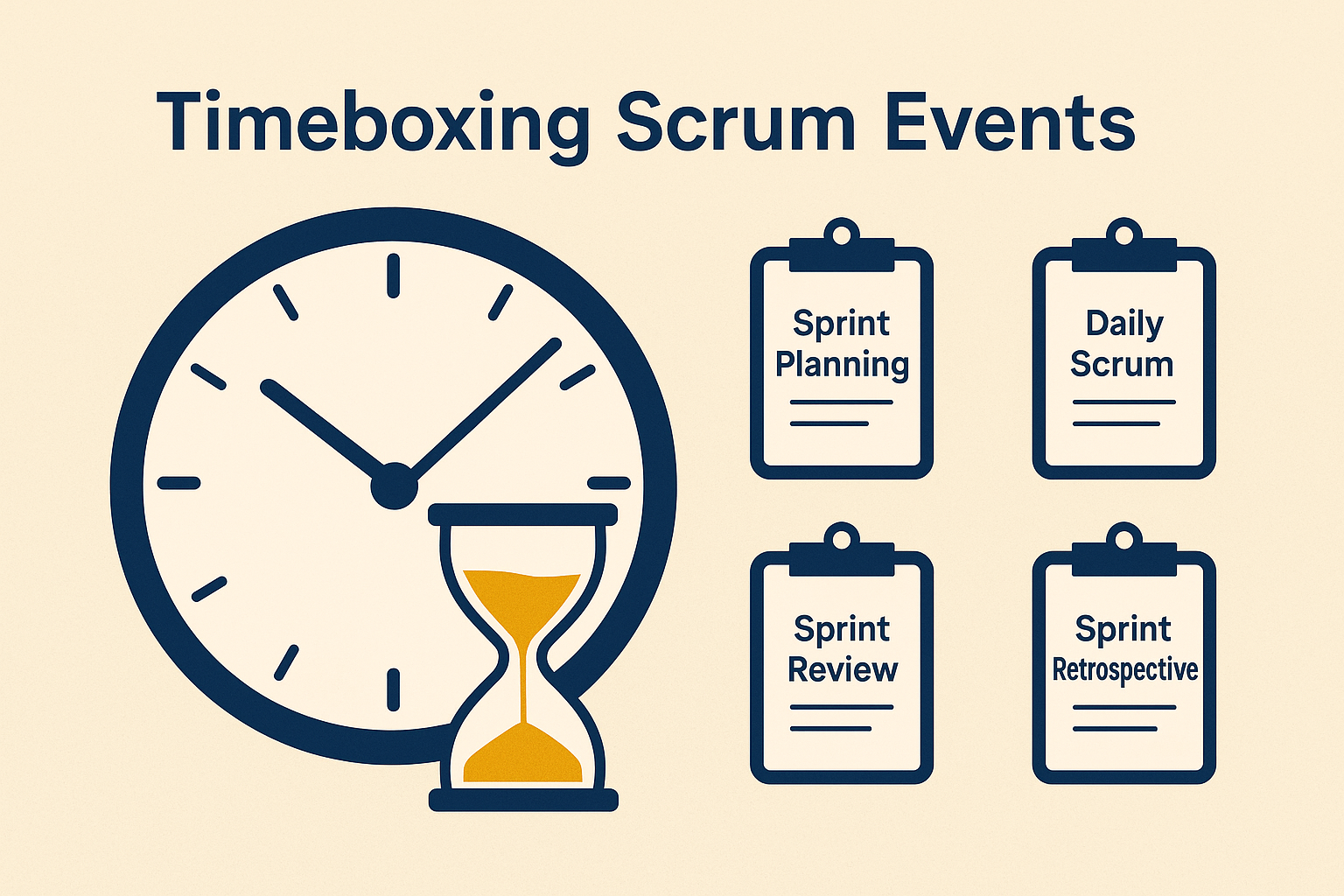Timeboxing Scrum Events
April, 2025
Timeboxing is a time management technique where a maximum duration is set for an event or task. It is a fundamental aspect of the Scrum framework, where each Scrum event has a defined timebox or upper limit.
The Scrum framework includes four main events: Sprint Planning, Daily Scrum, Sprint Review, and Sprint Retrospective—all of which exist within a container event called the Sprint. Each event has a prescribed timebox that should not be exceeded. Events can end earlier, but they should never exceed their allocated time. The only exception is the Sprint itself, which always adheres strictly to its defined length.
It is the Scrum Master’s primary responsibility to ensure that all Scrum events are conducted within their prescribed timeboxes.
Sprint
The Sprint is the container for all other Scrum events and development work. Its maximum duration is one month (or four weeks), although many teams opt for shorter sprints of one or two weeks.
Once a team decides on a specific sprint length, it should remain constant throughout the project. Frequently changing sprint duration disrupts rhythm and predictability. Keeping sprints the same length is like having consistent stair steps—predictable and easy to build momentum.
⏱️ Timebox of events within a sprint depends on the sprint’s length.
Can I End the Sprint Early?
Unlike other Scrum events, sprints are not ended early. Every sprint should be of equal length—no more, no less.
Exception: A Sprint may be canceled by the Product Owner only if the Sprint Goal becomes obsolete.
What if Work is Finished Early?
If the team finishes the Sprint Backlog early, they can:
- Pull in more work from the Product Backlog.
- Address technical debt.
- Refine the Product Backlog for upcoming sprints.
- Increase automated test coverage.
Sprint Planning
Sprint Planning kicks off the Sprint. For a one-month sprint, the timebox is 8 hours, with shorter sprints having proportionally shorter planning time.
| Sprint Duration | Planning Timebox |
|---|---|
| 4 weeks | 8 hours |
| 3 weeks | 6 hours |
| 2 weeks | 4 hours |
| 1 week | 2 hours |
Tips for Staying Within the Timebox
- Ensure only well-refined items enter Sprint Planning.
- Define and follow a clear Definition of Ready (DoR).
- Estimate backlog items in advance using techniques like story points or t-shirt sizing.
- Start the meeting on time and keep discussions focused.
- Ensure team members have access to and understand refined items before the meeting.
Daily Scrum
The Daily Scrum (stand-up) is a brief meeting held every working day by the Development Team to synchronize progress and identify impediments.
⏱️ Timebox: 15 minutes, regardless of sprint duration.
Tips for Staying Within the Timebox
- Keep team size between 3–9 members.
- Stick to the three questions:
- What did I do yesterday?
- What will I do today?
- Are there any impediments?
- Take detailed discussions offline.
- Only Development Team members actively participate; others observe.
Sprint Review
This event occurs at the end of the Sprint. The team demonstrates the Product Increment and gathers stakeholder feedback.
| Sprint Duration | Review Timebox |
|---|---|
| 4 weeks | 4 hours |
| 3 weeks | 3 hours |
| 2 weeks | 2 hours |
| 1 week | 1 hour |
Tips for Staying Within the Timebox
- Invite stakeholders in advance and share the agenda.
- Keep discussions focused on "what" was built, not "how."
- Encourage questions from knowledgeable stakeholders.
- Facilitate to keep the discussion on track.
Sprint Retrospective
The final event in the Sprint, the Retrospective allows the team to reflect and improve.
| Sprint Duration | Retrospective Timebox |
|---|---|
| 4 weeks | 3 hours |
| 3 weeks | 2 hours 15 minutes |
| 2 weeks | 1 hour 30 minutes |
| 1 week | 45 minutes |
Tips for Staying Within the Timebox
- Ask the team to reflect in advance on what went well and what didn’t.
- Guide discussions to be constructive—focus on improvement, not blame.
- Keep discussions concise and on-topic.
Backlog Refinement
While not a formal event in Scrum, Backlog Refinement is a crucial activity. The Scrum Guide recommends spending up to 10% of each Sprint on refinement.
This activity can happen through:
- Scheduled meetings
- Asynchronous collaboration via Jira, chat, email, etc.
| Sprint Duration | Max Refinement Time per Member |
|---|---|
| 4 weeks | 16 hours |
| 3 weeks | 12 hours |
| 2 weeks | 8 hours |
| 1 week | 4 hours |
Frequently Asked Questions
Can a Timeboxed Event End Early?
Yes! Timeboxing is the maximum limit. Events can end early if their objectives are achieved.
⛔ The only exception is the Sprint, which must run its full duration.
What If a Timebox is About to Expire Mid-Meeting?
Do not extend the meeting. Use a hard stop and discuss the issue in the Retrospective to improve time management for future events.
When Does a Sprint End and the Next Begin?
A Sprint ends immediately after the Sprint Retrospective. The next Sprint begins immediately—there is no gap between Sprints.
Example: If a Sprint ends on Friday at 6:00 PM, and Sprint Planning is scheduled for Monday morning, the new Sprint still starts on Friday, right after the Retrospective.
What is the Best Time for Daily Scrum?
Ideally, the Daily Scrum should happen first thing in the morning. For a 9:00 AM–6:00 PM shift, hold the stand-up between 9:00–9:30 AM.
Closing Note
Timeboxing is a core Scrum principle that ensures time is used efficiently. It promotes focus, rhythm, and a healthy balance between planning and execution.
Scrum Masters must act as timekeepers, helping teams maintain discipline while enabling agility. With the right practices, teams can stay productive, deliver consistently, and continuously improve.
